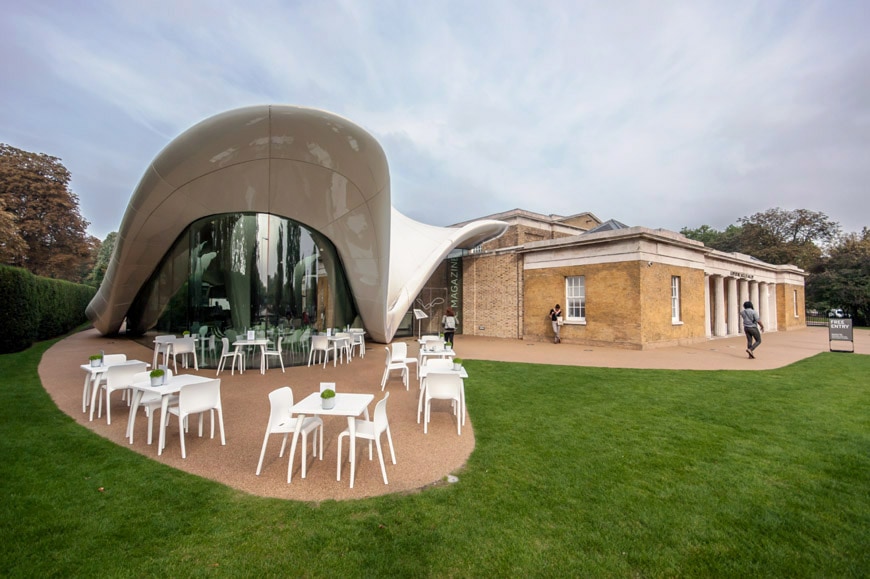The Serpentine Sackler Gallery is a contemporary art center, located in Kensington Gardens, central London. The historic building in which the gallery is housed was refurbished and extended under a design by famed Iraqui-born British architect Zaha Hadid.
Above: exterior view of the Serpentine Sackler Gallery, photo © Riccardo Bianchini / Inexhibit.
The Sackler Gallery is the latest venue opened by Serpentine Galleries in Kensington Gardens; the gallery was inaugurated in 2013 to complement the original Serpentine Gallery and is located just a few minutes walk from it on the opposite side of the Serpentine Lake.
The gallery refurbishment and extension were realized thanks to donations by Dr. Mortimer and Theresa Sackler Foundation, hence the gallery name, and by Bloomberg Philanthropies.
The Sackler Serpentine Gallery is housed in a Grade II listed building, a former gunpowder store built in 1805, extended by an iconic and futuristic expansion. Both the renovation of the historic building and the expansion were designed by Zaha Hadid architects. Along with gallery space for temporary exhibitions, the building also houses a social space, a restaurant, a shop, and offices for the Serpentine Galleries staff.
The Serpentine Sackler Gallery expansion designed by Zaha Hadid is a notable example of tensile architecture. Photo © Riccardo Bianchini / Inexhibit
The entrance of the historic building © 2013 Luke Hayes
Interior view of the historic building, © Riccardo Bianchini / Inexhibit.
The intervention included the careful restoration of the old warehouse, known as The Magazine, aimed at the same time to protect its historical legacy and emphasize its architectural value; therefore, the historically spurious parts of the building were removed while the original courtyards were covered to obtain a larger exhibition area. The resulting venue consists of a continuous gallery running around an inner “core” which contains the two raw-brick barrel-vaulted rooms where the gunpowder was once stored. Natural light, entering through several roof lights, contributes to further underline the visually powerful architecture of the old powder store.
Ed Atkins exhibition, installation views, Serpentine Sackler Gallery, London (11 June – 25 August 2014). Photographs © 2014 READS
Housing the restaurant and the social space, the expansion is visually very different from the regular and stereometric architecture of the adjoining historical building; together, they create a fascinating and dynamic combination of 19th-century and 21-st architecture.
The expansion is a beautiful example of tensile architecture consisting of a curvilinear structural frame made up of steel hollow profiles covered by a glass-fiber textile membrane stretched across them; five mushroom-shaped steel columns create the roof slopes and convey natural light inside the pavilion. The perimeter enclosure is composed of curved glass panels that, together with the lighting columns, create an ethereal space filled with natural light coming from all directions. The airy, almost temporary appearance of the new pavilion ideally complements the solid appearance of the historical building without prevailing on it.
The Sackler Gallery’s outdoor area was designed by Italian-born English garden designer Arabella Lennox-Boyd; Serpentine Galleries use it as an open-air gallery space for large art commissions and site-specific installations which often create and interplay with the fascinating context of the Kensington Gardens.
The Serpentine Sackler Gallery with the historic building in the foreground and the expansion in the background; photo © Riccardo Bianchini / Inexhibit.
Ground floor plan of the gallery with the expansion on the left. Image courtesy of Zaha Hadid Architects.
Exterior and interior view of the gallery expansion, photos © 2013 Luke Hayes, courtesy of Zaha Hadid Architects.
Photo © Riccardo Bianchini / Inexhibit.
